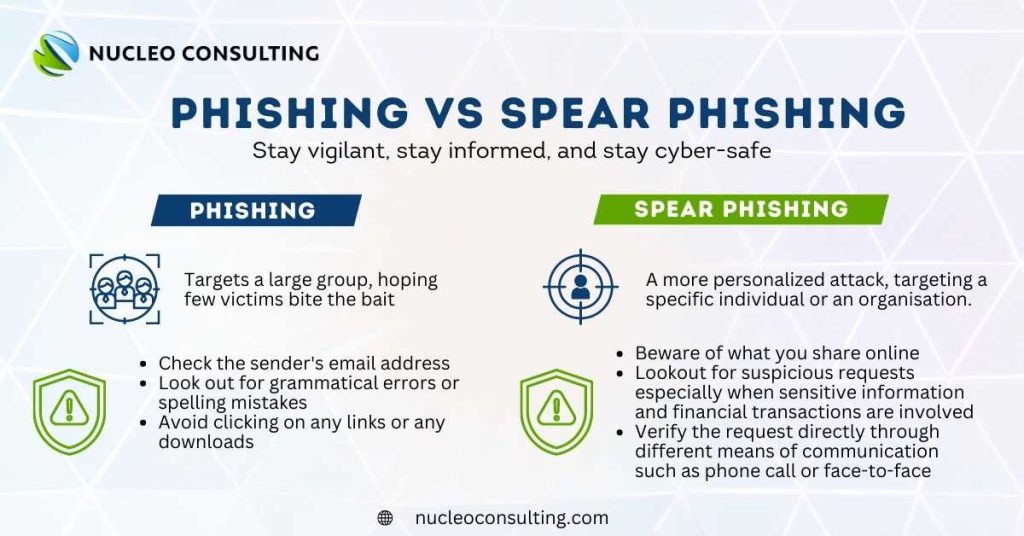Phishing vs Spear Phishing: What’s the Difference and How to Stay Safe?
[2 mins read]
In today’s technology-driven world, we rely heavily on electronic communication. However, technology is a double-edged sword.
Technology has revolutionized the way we live and work. Some benefits include increased efficiency, convenient communication, easy access to information, medical advancements, and environmental benefits. It is important to note that the progress of technology is paralleled by the increasing sophistication of cyber attacks.
Two of the most common tactics used by cybercriminals are phishing and spear phishing.

Phishing
Phishing, as the name suggests, is a fraudulent attempt to ‘fish’ out sensitive information by impersonating a trustworthy entity. This can include methods such as sending emails, text messages, or social media messages that appear to come from legitimate companies or someone you know. The goal of phishing is to lure unsuspecting victims into clicking on a link or downloading an attachment, which then installs malware on their devices or directs them to a fake website where they enter their login credentials or other personal information.
Spear Phishing
Spear phishing, on the other hand, is a more targeted form of phishing that is aimed at specific individuals or organizations. Cybercriminals research their victims and personalize their attacks to make them more convincing. They may use information obtained from social media or other public sources to create a sense of familiarity and trust with their target, increasing the likelihood of success. For example, a cybercriminal may send an email to an employee at a company that appears to come from their boss, asking for sensitive information or instructing them to transfer money to a fraudulent account.
The main difference between phishing and spear phishing is the level of personalization and targeting. While phishing attacks are generally sent to a large number of people in the hopes that a few will take the bait, spear phishing attacks are more carefully crafted and aimed at specific individuals. As a result, spear phishing attacks are often more successful, as the victim is more likely to trust the sender and take the bait.
Prevention
First and foremost, be cautious when receiving unsolicited emails or messages. Check the sender’s email address or contact number to ensure it is legitimate. Do not click on any links or download attachments if you are unsure about their source. Additionally, look out for red flags, such as urgent or threatening tone, requests for personal information or money, or messages that contain spelling or grammatical errors.
To prevent spear phishing attacks, take note of what you share on social media and other public sources. Beware of what you share and limit the amount of personal information you post. Sensitive information such as your full name, birthdate, phone number, and address should not be easily available. Additionally, be wary of unexpected requests or instructions from your boss or other colleagues, especially if they involve sensitive information or financial transactions. If you are unsure about the legitimacy of a request, verify it with the person directly through a different means of communication, such as a phone call or a face-to-face conversation. Remember, it is always better to be safe than sorry!
In conclusion, both phishing and spear phishing are serious threats to individuals and organizations and can have devastating consequences. By being aware of the differences between the two and taking steps to prevent them, we can better protect ourselves and safeguard our sensitive information. Stay vigilant, stay informed, and stay cyber-safe!
IT Tips | Phishing | Spear Phishing | Cyber Security | Cyber Safety | Personal Data Protection | Data Protection
